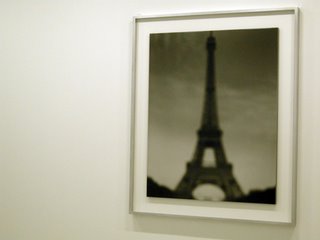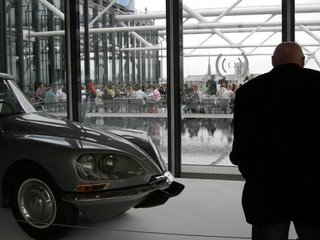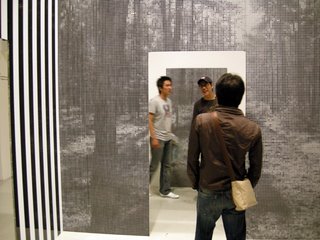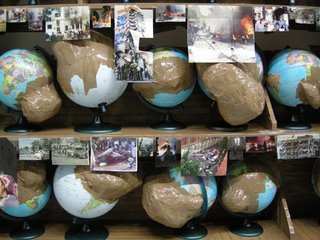Previous Post Next Post
Tuesday, August 21st, 2007
“AIRS DE PARIS” CENTRE POMPIDOU

Hiroshi Sugimoto, ” Eiffel Tower” 1998
“Airs De Paris”
25 April-15 August 2007
Centre Pompidou
www.centrepompidou.fr
Reflections: Angie Eng, Media Artist New York City
Installed in Paris for summer 2007

Gabriel Orozco, “La D.S.” 1970

Daniel Buren and Xavier Veihan
“La Cabane Eclatée au Paysagés Fantômes” 2006-07

Thomas Hirschorn, “Outgrowth” 2005
correspondent: NY Media Artist Angie Eng

Hiroshi Sugimoto, ” Eiffel Tower” 1998
“Airs De Paris”
25 April-15 August 2007
Centre Pompidou
www.centrepompidou.fr
Reflections: Angie Eng, Media Artist New York City
Installed in Paris for summer 2007
The cherry normally sits in the center on the top, a bright red, small, but like a ruby in grey, we notice it, toute suite in order to recognize- yes! Now it is a cake! Alfred Pacquement along with Christine Macel, Daniel Birnbaum decided to use as the show’s centerpiece, Duchamp’s ‘Airs de Paris’, a glass ornament gift engraved from both himself as Marcel and his nom de guerre, Rrose Selavy. Why would an artist sign with both names is a mystery, much like the themes, sub-themes, side-themes and cross-themes of this capital-C City exhibit. Not Surrealism, Not a conversation piece, (perhaps gifts play some part in this institutional exhibit of over 100 artists), Not not a sign of postmodern thinkers, this exhibit is a grand example of a quasi-anarchistic approach of Urbanism à la OMA and Radical Post-planning Asian Urbanism. In ‘Airs de Paris’ don’t expect breathing room, fountains in the square, a linear story, order, think Medieval Paris with royalty situated next to squatters, torture and eloquence, romance and drab, the intellectual and the idiot. Et voilà- French culture breeds double entendres and the artists, curators, installers take the liberty to interpret ‘Airs’ as true Urbanites in a glutinous mélange of creativity, leaving their guests with a bit of indigestion.
Rule number 1 in the Age of the Curator: When experiencing an institutional art show consider the text on the wall as yet another art piece. Wall text describes this is a show about Paris OR the chosen artists work/know/visit/ live in Paris. The latter more prevalent when one considers the artist roster. I recommend the visitor experience these blocks of black symbols like New York City parking regulation signage that leaves the driver in stop-motion perplexity. And parked at the entrance sits Orozco’s redesigned, re-functionalized Citroen 1970. Put the hit on the first or second track. But as we all know the true gems are really on the B-side. However, if we skip the introductory room where the actual cherry sits amongst distracting black ceiling goo and the reduction of On Kawara’s ‘Today Series’ you will be welcomed with Pierre Huyghe’s simulacra photo of Gordon Matta-Clark’s 1974 film screened on the adjacent wall. Unfortunately, we don’t get to experience one of Matta-Clark’s exterior desecrations, however one will soon discover that the exploding real-estate market has permeated the museum walls and each artist is slotted about 10 square meters. My impression that European shows are much more sensitive to giving the art object critical space in between, went out the door. Being a New Yorker with bionic over-sensory filters, I could adapt to the occasion and enjoy a few select œuvres.
Rule number 1 in the Age of the Curator: When experiencing an institutional art show consider the text on the wall as yet another art piece. Wall text describes this is a show about Paris OR the chosen artists work/know/visit/ live in Paris. The latter more prevalent when one considers the artist roster. I recommend the visitor experience these blocks of black symbols like New York City parking regulation signage that leaves the driver in stop-motion perplexity. And parked at the entrance sits Orozco’s redesigned, re-functionalized Citroen 1970. Put the hit on the first or second track. But as we all know the true gems are really on the B-side. However, if we skip the introductory room where the actual cherry sits amongst distracting black ceiling goo and the reduction of On Kawara’s ‘Today Series’ you will be welcomed with Pierre Huyghe’s simulacra photo of Gordon Matta-Clark’s 1974 film screened on the adjacent wall. Unfortunately, we don’t get to experience one of Matta-Clark’s exterior desecrations, however one will soon discover that the exploding real-estate market has permeated the museum walls and each artist is slotted about 10 square meters. My impression that European shows are much more sensitive to giving the art object critical space in between, went out the door. Being a New Yorker with bionic over-sensory filters, I could adapt to the occasion and enjoy a few select œuvres.

Gabriel Orozco, “La D.S.” 1970
In contrast, but equally promising, we are led to box number #3 with Daniel Buren’s Xavier Veihan’s ‘La Cabane éclatee au Paysagés Fantômes, 2006-07’ (No need to translate as it sounds much better in French) These two urbanites are clever to create a solution to bring the illusion of nature inside our lives and at the very least to remind us amongst the simulated and built environment we have a faint memory of the organic. The next course is Valerie Jouve’s self-conscious eye of beautiful roaming city compositions, a similar aesthetic to a Chris Marker dérive.
By the 4th course it hit me that this is not French, but Fusion cuisine! A newly constructed wall is placed in the middle of the room entitled ‘Free Space…” Carefully in the center is a Banksy-styled graffiti work by Mircea Cantor. Its preciousness irritated me in the name of Graffiti Art. The piece would have exponentially gained merit had it been sprayed on one of those glorious blue tubes on the exterior of the Pompidou. Her other work, a light box photo with the words ‘unpredictable future’ written on a misty window is a process yet to be exploited. I had an image of the artist directly connected with weather. She could only execute work in cold temperatures. The over-heated rooms creating condensation on the windows. Time would be critical. Her canvas available for a very short period of time. She would have to run from place to place writing temporal messages on store and car windows. Delivery is key. And even the other notable artist in this room, Jean-Luc Moulène cheats himself by installing a periodical entitled, ‘Le Tunnel’ as an object. This poetic work takes the form of newsprint, a beautiful nostalgic medium. Somehow the crate of stacked newspapers and each paper taped to the wall, lose the identity of the piece. A curatorial choice? Surely this couldn’t be the idea of the artist to re-CONtextualize his words and reverse his modus operandi.
By the 4th course it hit me that this is not French, but Fusion cuisine! A newly constructed wall is placed in the middle of the room entitled ‘Free Space…” Carefully in the center is a Banksy-styled graffiti work by Mircea Cantor. Its preciousness irritated me in the name of Graffiti Art. The piece would have exponentially gained merit had it been sprayed on one of those glorious blue tubes on the exterior of the Pompidou. Her other work, a light box photo with the words ‘unpredictable future’ written on a misty window is a process yet to be exploited. I had an image of the artist directly connected with weather. She could only execute work in cold temperatures. The over-heated rooms creating condensation on the windows. Time would be critical. Her canvas available for a very short period of time. She would have to run from place to place writing temporal messages on store and car windows. Delivery is key. And even the other notable artist in this room, Jean-Luc Moulène cheats himself by installing a periodical entitled, ‘Le Tunnel’ as an object. This poetic work takes the form of newsprint, a beautiful nostalgic medium. Somehow the crate of stacked newspapers and each paper taped to the wall, lose the identity of the piece. A curatorial choice? Surely this couldn’t be the idea of the artist to re-CONtextualize his words and reverse his modus operandi.

Daniel Buren and Xavier Veihan
“La Cabane Eclatée au Paysagés Fantômes” 2006-07
In global exchange, an anarchic (let’s be nicer) in a more organic fashion, isn’t copyright a moot point? The moderrn eye searching for an original idea in a contemporary vista will be blinded. Rainier Lericolais’ electro-pop music with the accompanying statement ‘to subvert the system’ providing his music free on-line is questionable in intent. Now if he were to raise € 30.000 in art grants to make a CD and distribute 20,000 copies in a newspaper for free, now we are talking ‘Free Space…’
On the B-side we are welcomed with Chris Marker’s ‘Zapping Zone.’ Made 25 years after Nam June Paik’s television symphonies, nonetheless this media orchestra is a visual-audio mirror of split second information delivery. 35 years af ter the onset of the digital age, we witness how the brains of our children process information. Beauty would not need to be repeated, as we would find beauty in repetition. In Thomas Hirschorn’s ‘Outgrowth’ 2005 I feel human again. Like a taxidermist reconfiguring animals with malignant tumors, Hirschorn constructs paper globes each with their war-torn cancerous growths. Newspaper clippings hang under each shelf to provide reference of where and when each growth appeared. Anxiety is highlighted by the masking tape that crudely shapes each deformation. Light yet rich in subject, contemporary and reminiscent, reflective without pomp I could end the meal here. Perhaps mentally, emotionally, physically I did. The music played on for another good 6 courses. After this point, I was half listening.
Identity Room 8- a colored ghetto. Didn’t we do this in the late 80’s early 90’s? An honorable mention is Huang Yong Ping’s ‘Carte du Monde’ 2006-2046. A globe sitting naked in the corner is pealed like an orange. Its endless peal spreads across the wall. Like a palm-reader Huang pins MISfortunes to hotspots on localities.
Although there was endless chatter, I could catch a few smart dialogues. My interest lay in the hands of the more experienced and wiser. Hiroshi Sugimoto and Sophie Calle, much like Buren-Veihan and Matta-Clark/Huyghe teamed up and found a way to make memorable statements in a dizzying atmosphere. Sugimoto in his dreamy extreme slow shutter aesthetic would select his ’98 Eiffel Tower (oh yes, the show about Paris) and Calle’s 1979 journal entry ‘Tour Eiffel’ would leave as a pair. However another duo, Louis Bourgeois’ marble curved houses enclosed by Koo Jeong-a’s 1001 drawings was just plain wrong. Have we been reduced to the approach of matching the sofa with the painting? Artists, we can’t be pushed around like this!
On the B-side we are welcomed with Chris Marker’s ‘Zapping Zone.’ Made 25 years after Nam June Paik’s television symphonies, nonetheless this media orchestra is a visual-audio mirror of split second information delivery. 35 years af ter the onset of the digital age, we witness how the brains of our children process information. Beauty would not need to be repeated, as we would find beauty in repetition. In Thomas Hirschorn’s ‘Outgrowth’ 2005 I feel human again. Like a taxidermist reconfiguring animals with malignant tumors, Hirschorn constructs paper globes each with their war-torn cancerous growths. Newspaper clippings hang under each shelf to provide reference of where and when each growth appeared. Anxiety is highlighted by the masking tape that crudely shapes each deformation. Light yet rich in subject, contemporary and reminiscent, reflective without pomp I could end the meal here. Perhaps mentally, emotionally, physically I did. The music played on for another good 6 courses. After this point, I was half listening.
Identity Room 8- a colored ghetto. Didn’t we do this in the late 80’s early 90’s? An honorable mention is Huang Yong Ping’s ‘Carte du Monde’ 2006-2046. A globe sitting naked in the corner is pealed like an orange. Its endless peal spreads across the wall. Like a palm-reader Huang pins MISfortunes to hotspots on localities.
Although there was endless chatter, I could catch a few smart dialogues. My interest lay in the hands of the more experienced and wiser. Hiroshi Sugimoto and Sophie Calle, much like Buren-Veihan and Matta-Clark/Huyghe teamed up and found a way to make memorable statements in a dizzying atmosphere. Sugimoto in his dreamy extreme slow shutter aesthetic would select his ’98 Eiffel Tower (oh yes, the show about Paris) and Calle’s 1979 journal entry ‘Tour Eiffel’ would leave as a pair. However another duo, Louis Bourgeois’ marble curved houses enclosed by Koo Jeong-a’s 1001 drawings was just plain wrong. Have we been reduced to the approach of matching the sofa with the painting? Artists, we can’t be pushed around like this!

Thomas Hirschorn, “Outgrowth” 2005
Yes, I’m exhausted at this point but I must save energy as my peers have a piece at the end of the tunnel. But before I reach them, I am pleasantly awoken by Philipe Rahms’ psychological sound room, ‘Diurnisme’ A bright yellow James Turrellesque light emanates from another team of artists’ designed felt wall. You enter a hyper-sensory room that simulates night time when the brain is producing melatonin. Sitting inside John Field’s ‘Nocturnes for Piano’, believe it or not, in the blinding light the visitor feels at rest. Thank you.
So where are my peers? He-He Associates (Helen Evans and Heiko Hansen) an English and German duo installed in Paris are working on digital visualizations of nature rejuvenated and damaged. Had I not the postcard, I would have never found their piece installed in a small window, the view of Paris altered by a transparent digital screen communicating with ‘Airparif’ to measure the level of air pollution. I recall having seen something similar in a lab in Santa Barbara, when as a poor college student I was hired for $8/hour to go on a treadmill in a enclosed room as the air quality increased in pollutants. One could see the pollution levels on graphs, numbers, colors, etc. In the digital age the role of the artist has been rediscovered with many artists now collaborating with scientists. I could imagine the screen was pricey, but couldn’t help think that the project would be more effective installed in the café windows where people leisurely tried to enjoy the view. Again in a large exhibition and no fault of the individual artist, context is sacrificed and the works suffer.
The architecture/design room arrives unfashionably one hour late. However, the brilliance of Zaha Hadid is side-noted, the infrared hot air balloon interesting inside its trade show installation. Like most summer group exhibitions, this one also leaves you exhausted in search for the exit. As an experience, I did feel as if I were in a City- anonymous, sensory-charged, crowded, over-exposed. Surpassing my limit, I’m in great need of a digestive. Although stimulated, I’m happy that not all cities are like the ‘Airs de Paris’ and I head toward a quiet intimate corner of the Parisian café to take my espresso.
So where are my peers? He-He Associates (Helen Evans and Heiko Hansen) an English and German duo installed in Paris are working on digital visualizations of nature rejuvenated and damaged. Had I not the postcard, I would have never found their piece installed in a small window, the view of Paris altered by a transparent digital screen communicating with ‘Airparif’ to measure the level of air pollution. I recall having seen something similar in a lab in Santa Barbara, when as a poor college student I was hired for $8/hour to go on a treadmill in a enclosed room as the air quality increased in pollutants. One could see the pollution levels on graphs, numbers, colors, etc. In the digital age the role of the artist has been rediscovered with many artists now collaborating with scientists. I could imagine the screen was pricey, but couldn’t help think that the project would be more effective installed in the café windows where people leisurely tried to enjoy the view. Again in a large exhibition and no fault of the individual artist, context is sacrificed and the works suffer.
The architecture/design room arrives unfashionably one hour late. However, the brilliance of Zaha Hadid is side-noted, the infrared hot air balloon interesting inside its trade show installation. Like most summer group exhibitions, this one also leaves you exhausted in search for the exit. As an experience, I did feel as if I were in a City- anonymous, sensory-charged, crowded, over-exposed. Surpassing my limit, I’m in great need of a digestive. Although stimulated, I’m happy that not all cities are like the ‘Airs de Paris’ and I head toward a quiet intimate corner of the Parisian café to take my espresso.